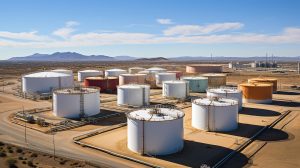Double Bunded Diesel Tank: The Smart Choice for Safe and Efficient Fuel Storage
If you’re seeking a secure and environmentally friendly way to store fuel, a double bunded diesel tank is the ideal solution. Whether you manage a construction site, a farm, or a fleet of vehicles, investing in this type of storage tank ensures both safety and compliance.
In this guide, you’ll discover the benefits, uses, and maintenance of double bunded diesel tanks. Let’s dive into everything you need to know.
What is a Double Bunded Diesel Tank?
A double bunded diesel tank, also known as a self-bunded tank, is a fuel storage container with two layers. The inner tank holds the diesel, while the outer tank acts as a protective barrier. If the inner tank leaks, the outer layer catches the fuel, preventing environmental contamination.
This double-layer design provides added protection and meets strict safety standards, making it a popular choice for commercial and industrial applications.
Why Choose a Double Bunded Diesel Tank?
Here are several reasons why this type of tank is widely used:
- Enhanced safety: The secondary containment prevents spills and leaks.
- Regulation compliant: Meets environmental safety regulations.
- Durability: Made with corrosion-resistant materials for a longer life span.
- Versatility: Suitable for use in various industries.
- Ease of installation: Can be placed above ground without additional containment structures.
These features make double bunded diesel tanks a smart, long-term investment.
Common Applications
Double bunded diesel tanks are used in many industries:
- Construction sites for fueling machinery.
- Agriculture for storing diesel used in tractors and harvesters.
- Transport and logistics for fueling delivery vehicles.
- Mining operations for powering equipment.
- Generators to ensure backup power.
Their adaptability makes them essential for fuel management in these sectors.
Key Features of Double Bunded Diesel Tanks
When selecting a tank, you should look for important features:
- Leak detection systems
- Integrated pumps and meters
- Lockable fill points
- Level indicators
- UV and weather-resistant coatings
These built-in features improve usability and monitoring, reducing maintenance costs.
Choosing the Right Tank Size
The size you choose depends on your fuel consumption and available space. Here are some typical options:
- Small tanks (500L – 2,000L): Great for small businesses and farms.
- Medium tanks (2,000L – 10,000L): Suitable for medium-scale operations.
- Large tanks (10,000L and above): Designed for industrial applications.
Understanding your needs will help you select the most efficient tank.
Benefits of Using a Double Bunded Diesel Tank
1. Environmental Protection
Because of the dual-layer design, these tanks prevent diesel from seeping into the ground or water supply.
2. Cost Savings
Fewer spills and maintenance issues mean lower operational costs over time.
3. Compliance with Regulations
Many regions require bunded tanks for storing large volumes of fuel.
4. Flexibility and Portability
Some models are skid-mounted or have forklift pockets, allowing for easy movement.
5. Reduced Downtime
Having diesel readily available on-site ensures you keep operations running smoothly.
Maintenance Tips
To ensure your tank lasts for years:
- Inspect tanks regularly for corrosion or damage
- Clean the filters and replace them as needed
- Check pump function and hoses
- Schedule annual professional inspections
These steps help avoid costly repairs or environmental hazards.
Buying Tips
When buying a double bunded diesel tank, always:
- Choose certified suppliers
- Ensure compatibility with your existing systems
- Check for warranty and support services
- Consider delivery and installation options
Making the right purchase will pay off in safety and efficiency.
Frequently Asked Questions
Q: What does “double bunded” mean? A: It means the tank has two walls—an inner and an outer layer—for added protection.
Q: Are these tanks suitable for outdoor use? A: Yes. They are designed to withstand harsh weather and UV exposure.
Q: Do I need planning permission to install one? A: This depends on your local regulations. Always check with authorities.
Q: Can I store other fuels in a double bunded diesel tank? A: Some tanks are compatible with other fuels, but confirm this with the manufacturer first.
Conclusion: Secure Your Fuel Supply Today
A double bunded diesel tank offers safety, durability, and peace of mind. Whether you’re managing a small farm or running a large-scale operation, this investment ensures efficient fuel storage and compliance with regulations.
Don’t wait for a fuel spill to take action. Upgrade your storage system now and protect your operation and the environment.

